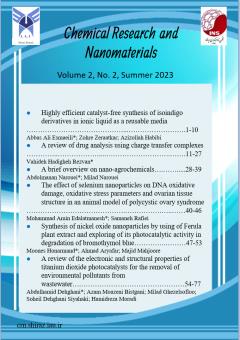The effect of selenium nanoparticles on DNA oxidative damage, oxidative stress parameters and ovarian tissue structure in an animal model of polycystic ovary syndrome
Subject Areas : Applications of NanostructuresMohammad Amin Edalatmanesh 1 , Samaneh Rafiei 2
1 - Department of Biology, Faculty of Sciences, Shiraz Branch, Islamic Azad University, Shiraz, Iran
2 - Department of Exercise Physiology, Faculty of Physical Education and Sport Sciences, University of Tehran, Tehran, Iran
Keywords: Rat, Polycystic ovary syndrome, Oxidative stress, selenium nanoparticles,
Abstract :
Polycystic ovary syndrome (PCOS) is associated with hormonal-metabolic disorders, oxidative stress and ovulation disorders. The present study evaluated the effect of selenium nanoparticles (SeNPs) on the activity of antioxidant enzymes and ovarian tissue structure and oxidative DNA damage in the polycystic ovary syndrome (PCOS) model. 32 female Wistar rats were divided into 4 control groups, PCOS, PCOS+SeNPs0.1 and PCOS+SeNPs0.1. Polycystic ovary syndrome was induced by a single intramuscular injection of estradiol valerate (4 mg/kg) and SeNPs with doses of 0.1 and 0.2 mg/kg were administered orally for 14 days. At the end, the tissue level of superoxide dismutase (SOD), catalase (CAT) enzymes, content of malondialdehyde (MDA) and 8-hydroxydeoxyguanosine (8-OHdG) in the ovarian tissue was measured by ELISA technique and the ovarian tissue structure was examined histopathologically. A significant decrease in the number of follicular cysts, 8-OHdG and MDA levels along with a significant increase in tissue levels of SOD and CAT enzymes were seen in the SeNPs treatment groups compared to the PCOS group. In fact, SeNPs with antioxidant function improved ovarian tissue structure in polycystic ovary syndrome model.
1. S. Patel, J, Steroid. Biochem. Mol. Biol. 182, 27-36 (2018)
2. C. Delcour, G. Robin, J. Young, D. Dewailly, Clin. Med. Insights. Reprod. Health. 9, 1179558119871921 (2019)
3. E. Palioura, E. Diamanti-Kandarakis, Rev. Endocr. Metab. Disord. 16(4), 365-712015 (2015)
4. N. Gleicher, S. Darmon, P. Patrizio, D.H. Barad, Biomedicines. 10(7), 1505 (2022)
5. H. Liu, J. Xie, L. Fan, Y. Xia, X. Peng, J. Zhou, X. Ni, Oxid. Med. Cell. Longev. 2022, 8011850 (2022)
6. E. Rudnicka, A. M. Duszewska, M. Kucharski, P. Tyczyński, R. Smolarczyk, Reproduction. 164(6), F145-F154 (2022)
7. M. Mohammadi, Int. J. Prev. Med. 17, 10:86 (2019)
8. H. Shan, R. Luo, X. Guo, R. Li, Z. Ye, T. Peng, F. Liu, Z. Yang, Front. Pharmacol. 13, 904942 (2022)
9. A-M. E. Abdel-Moneim, A. M. Shehata, N. G. Mohamed, A. M. Elbaz, N. S. Ibrahim, Biol. Trace. Elem. Res. 200, 768–779 (2022)
10. R. M. P. Gutiérrez, J. T. Gómez, R. B. Urby, J. G. C. Soto, H. R. Parra, Molecules. 27(17), 5642 (2022)
11. J-S. Zhang, X-Y. Gao, L-D. Zhang, Y-P. Bao, BioFactors. 15(1), 27–38 (2001)
12. S. Hariharan, S. Dharmaraj. Inflammopharmacology. 28(3), 667–695 (2020)
13. M. A. Dkhil, R. Zrieq, S. Al-Quraishy, Molecules. 21(11), 1517 (2016)
14. A. B. E. Abdallah, M. A. El-Ghannam, A. A. Hasan, Biol. Trace. Elem. Res. (2023) https://doi.org/10.1007/s12011-023-03616-0
15. S. Rafiei, M. A. Edalatmanesh, Feyz. 22(6), 564-572 (2018)
16. B. F. Mazloom, M. A. Edalatmanesh, S.E. Hosseini, Comp. Clin.Pathol. 28(10), 281-1286 (2019)
17. M.Ebrahimi, N. Abarshahr, M. A. Edalatmanesh, J. Anim. Biol. 15(1), 191-203 (2022)
18. R. L.Rosenfield, J. Pediatr. Adolesc. Gynecol. 28(6), 412-419 (2015)
19. F. Khazaei, E. Ghanbari, M. Khazaei, Int. J. Reprod. Biomed. 19(6), 515-524 (2021)
20. Y. Zhang, M. Hu, F. Meng, X. Sun, H. Xu, J. Zhang, EBioMedicine. 18, 157-170 (2017)
21. R. Gharaei, F. Mahdavinezhad, E. Samadian, J. Asadi, Z. Ashrafnezhad, L. Kashani, F. Amidi, J. Assist. Reprod. Genet. 38(11), 2817-2831 (2021)
22. L. V. Papp, A. Holmgren, K. K. Khanna, Anti-oxidants. Redox. Signaling. 12(7), 793–795 (2010)
23. C. Ferro, H. F. Florindo, H. A. Santos, Adv. Healthcare. Mater. 10(16), 2100598 (2021)
24. C. Wu, F. Lin, S. Qiu, Z. Jiang, PLoS. One. 9(6), e99155 (2014)
25. M. A. Butt, A. Ullah, M. M. Kiyani, S. Jahan, Int. J. Biomed. Nanosci. Nanotechnol. 4(1–2), 49–69 (2020)


